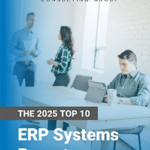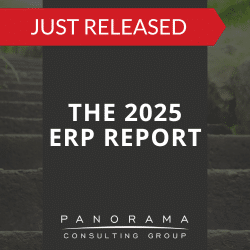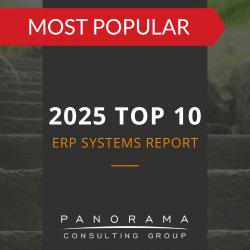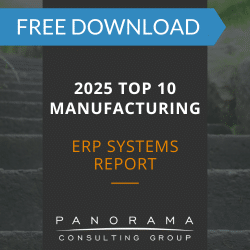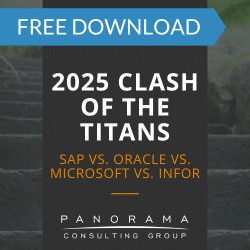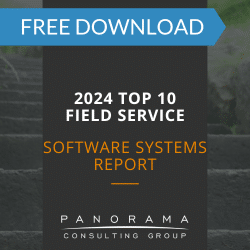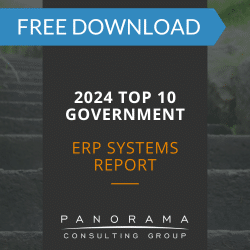- Microsoft Dynamics GP is reaching end of life, requiring organizations to migrate to a modern ERP system to avoid security risks and operational inefficiencies.
- A government agency recently worked with Panorama to transition from Dynamics GP to Microsoft Dynamics 365, improving real-time data access.
- Companies planning an ERP migration should prioritize business needs over vendor sales tactics and seek independent guidance to avoid costly missteps.
- Migrating from Dynamics GP is more than just a technology upgrade—it’s an opportunity to adopt AI, automation, and advanced analytics.
Organizations across industries have relied on Microsoft Dynamics GP for decades. With the end of support for Dynamics GP quickly approaching, these organizations are understandably nervous about migrating to a new ERP system.
However, with careful planning, a strategic selection process, and a focus on organizational change management (OCM), this transition can be a success story.
In fact, a government agency in Texas recently used this software sunset as a catalyst for digital transformation.
Today, we’re breaking down the agency’s journey, highlighting lessons learned, and providing actionable insights for organizations preparing for Microsoft Dynamics GP end of life. Whether you’re in government, manufacturing, healthcare, or another sector, these strategies will help you navigate ERP system end-of-life management effectively.
The 2025 Top 10 ERP Systems Report
What vendors are you considering for your ERP implementation? This list is a helpful starting point.
Overview of the ERP Project
The organization’s ERP landscape was becoming increasingly unsustainable. Their use of Microsoft Dynamics GP, coupled with various standalone applications, resulted in inefficiencies, data silos, and limited real-time visibility.
With Dynamics GP reaching end of life, they recognized the urgency of finding a modern ERP solution that would address their evolving needs.
Project Goals
The agency set out to achieve several critical objectives:
- Consolidate Organizational Data – They needed a unified database that could integrate financials, human resources, supply chain, and operational data to support more informed decision-making.
- Enable Real-Time Reporting – Decision-makers required immediate access to key performance indicators and operational insights without relying on time-consuming manual reports.
- Eliminate Redundant Systems – Reducing the complexity of maintaining multiple disparate software solutions was a priority.
Lessons Learned From a Successful ERP System Migration
Panorama’s team of ERP experts guided the government agency through a rigorous selection process that ultimately delivered a strong ROI.
While every ERP migration is unique, the agency’s success offers some universal takeaways for organizations facing Microsoft Dynamics GP end of life.
1. Requirements Gathering is More Than a Checklist
Many organizations make the mistake of rushing into ERP selection before fully understanding their needs.
The agency’s success was rooted in a detailed process mapping exercise that identified inefficiencies and business process gaps. This helped the organization arrive at a list of future state requirements that enabled them to accomplish the following:
- Prioritize their differentiating requirements during software evaluation.
- Focus primarily on the capabilities that differ between systems.
- Adopt best practices employed by best-in-class organizations and/or enabled by modern technology.
Expert Insight
We recommend setting all biases aside when replacing a sunsetting ERP system. These biases can make you more susceptible to vendor misrepresentation as you might be less critical of a vendor of which you have a good opinion. By remaining focused on specific requirements, the government agency applied the same measure to all contenders instead of showing favoritism to the incumbent ERP vendor (Microsoft).
2. Vendor Selection Should Be Data-Driven, Not Sales-Driven
ERP vendors excel at selling their vision, but that vision doesn’t always align with an organization’s realities.
A structured request for proposal (RFP) and vendor scoring process enabled the agency to evaluate systems effectively against competing solutions. By assessing functional fit, technical architecture, and total cost of ownership, they evaluated five different vendors, while focusing on their organization’s specific needs.
Expert Insight
In the ERP consulting industry, it’s common practice to recommend solutions based on referral fees and other financial ties. If you want to remain focused on your business needs, you not only need to follow a structured selection process, but you need an independent advisor, like Panorama Consulting, to shepherd the process. Learn about the importance of independent ERP selection.
3. Change Management is Not Optional
Initially, the agency viewed change management as a secondary concern. However, they quickly realized that without a comprehensive OCM strategy, user adoption would be an uphill battle.
An organizational readiness assessment identified key resistance points, allowing the agency’s leadership team to develop a tailored OCM plan. This guided the agency in preparing end-users for the transition from Dynamics GP to Dynamics 365 (their ultimate choice).
Expert Insight
The consultants on our Software Expert Witness team will tell you that employee resistance is one of the leading causes of ERP failure. An OCM strategy that includes a sponsorship roadmap, a communication plan, and end-user training can mean the difference between success and failure.
4. Future-Proofing is Essential
Beyond meeting current needs, the agency ensured their chosen ERP solution was adaptable for the future. Their decision to select Microsoft Dynamics 365 Business Central was strongly influenced by its scalability, integration capabilities, and robust reporting functionality.
While these qualities are shared with other top ERP systems, Dynamics 365 ultimately had the highest degree of fit for the agency’s requirements.
Expert Insight
We recommend selecting a system that supports evolving business models, regulatory shifts, and emerging technologies. Cloud-based solutions, in particular, offer scalability and continuous innovation. However, not all cloud-based solutions are created equal—some vendors invest heavily in continuous innovation, while others simply repackage old technology in a cloud-hosted format. CEOs must look beyond the cloud label and assess whether a vendor has a proven track record of enhancing its ERP offerings.
Learn More About ERP Migration Success Factors
While Microsoft Dynamics GP end of life is an inflection point, it doesn’t have to be a crisis. With a structured ERP selection process and a focus on future-proofing, organizations can turn this transition into an opportunity for digital transformation.
This government agency’s success story underscores key best practices that organizations across industries can adopt as they approach Dynamics GP end of support planning.
For executives navigating ERP system end-of-life management, the key takeaway is clear: this transition is not just about replacing old software—it’s about redefining how your organization operates and competes in the post-digital era.
Contact our independent ERP consultants to turn your ERP migration into your next success story!
